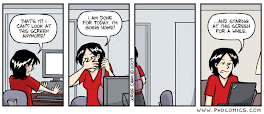One feature of myopic people is that when they look far away and see blurred, tey unconsciously learn that their vision improve when squeezing their eyelids to a narrow opening.
The reason why this happens is because when an eye is “focused”, the image of the point that it looks to, is equivalent to a clear point; but when the eye is “out of focus”, the image of the point is equivalent to a blur circle.


In order for you to understand better, I will explain the difference between “optical image” and “retinal image”. We should begin from two premises:
The size of this blur circle depends on two factors: the distance of the optical image from the retina and the pupil size.
 So, when a myopic person squeezes her eyelids, she just reduces the quantity of light rays that get into her eyes, and with this, she achieves decreasing the size of the circle on the retina, causing a more clear image.
So, when a myopic person squeezes her eyelids, she just reduces the quantity of light rays that get into her eyes, and with this, she achieves decreasing the size of the circle on the retina, causing a more clear image.
It is proved that for the Visual Acuity to be good, the pupil size must range between 2 and 5 mm: when it is smaller than 2 mm, the diffraction effects of the light tend to reduce Visual Acuity; whereas if it is bigger than 5 mm, spherical aberration is the factor may reduce it.
Therefore, in order to know whether a child has myopia, a test can be performed: the child covers one eye whereas with the other eye, she looks some letters far away from her, through a cardboard with a small hole of around 1 mm (it is like a homemade “pinhole”). If the child has myopia she will see better when looking through the hole (it is just as if she squeeze her eye lids to a narrow opening); if the child is emmetrope (not refractive error), she will not see any difference.
RELATED POSTS
Refractive disorders: Myopia (1).Vision and Symptoms
Refractive disorders: Myopia (2) Kinds and factors
Refractive disorders: Myopia (3). Solutions
Refractive visual Disorders. Some clarifications.
Some numbers...
The reason why this happens is because when an eye is “focused”, the image of the point that it looks to, is equivalent to a clear point; but when the eye is “out of focus”, the image of the point is equivalent to a blur circle.


In order for you to understand better, I will explain the difference between “optical image” and “retinal image”. We should begin from two premises:
- Optical image is formed by the optical system of the eye. It is always clear and it may or may not coincide with the image formed on the retina.
- Retinal image is formed on the retina, so it may be blurred or clear.
If the optical image is sharply focused on the retina, both images are one and the same; but if the optical image of a point object is not focused on the retina, the retinal image will be a blur circle.
The size of this blur circle depends on two factors: the distance of the optical image from the retina and the pupil size.
- For a constant pupil size, the distance of the optical image from the retina (or the size of blur circle), is determined by the refractive error; the lesser the refractive error, the closer the image will from the retina, and therefore, the lesser the blur circle size will be.
- In the other hand, for a given position of the optical image, if the pupil size varies (varying the brightness of the environment or squeezing the eye lids), the circle size varies too, so if the pupil size is smaller, the circle will be smaller too.
 So, when a myopic person squeezes her eyelids, she just reduces the quantity of light rays that get into her eyes, and with this, she achieves decreasing the size of the circle on the retina, causing a more clear image.
So, when a myopic person squeezes her eyelids, she just reduces the quantity of light rays that get into her eyes, and with this, she achieves decreasing the size of the circle on the retina, causing a more clear image.It is proved that for the Visual Acuity to be good, the pupil size must range between 2 and 5 mm: when it is smaller than 2 mm, the diffraction effects of the light tend to reduce Visual Acuity; whereas if it is bigger than 5 mm, spherical aberration is the factor may reduce it.
Therefore, in order to know whether a child has myopia, a test can be performed: the child covers one eye whereas with the other eye, she looks some letters far away from her, through a cardboard with a small hole of around 1 mm (it is like a homemade “pinhole”). If the child has myopia she will see better when looking through the hole (it is just as if she squeeze her eye lids to a narrow opening); if the child is emmetrope (not refractive error), she will not see any difference.
RELATED POSTS
Refractive disorders: Myopia (1).Vision and Symptoms
Refractive disorders: Myopia (2) Kinds and factors
Refractive disorders: Myopia (3). Solutions
Refractive visual Disorders. Some clarifications.
Some numbers...





